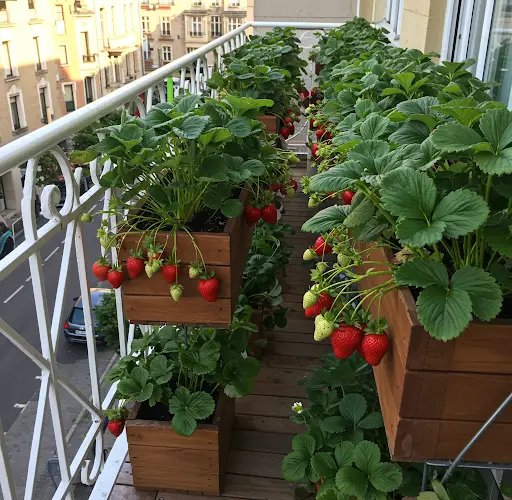Growing Strawberries from Seeds: Tips for a Balcony Full of Sweet, Juicy Fruits
Growing strawberries from seeds may seem like a slow process, but it’s one of the most rewarding ways to fill your balcony with fresh, sweet berries. Even if you have limited space, you can successfully grow strawberries in containers and enjoy a fruitful harvest right from your apartment.
Strawberries are relatively low-maintenance once established, and they grow well in pots, hanging baskets, and vertical planters. This makes them a perfect choice for balconies, patios, or small outdoor nooks. Here’s a step-by-step guide to growing strawberries from seeds and getting a high yield, even in a small space.
Why Grow Strawberries from Seeds?
While many gardeners prefer buying young plants or runners, growing strawberries from seed has unique advantages:
-
Cost-effective – A packet of seeds yields many plants for a fraction of the price of nursery starts.
-
More variety – Seeds offer access to rare and heirloom types not commonly sold as seedlings.
-
Stronger adaptation – Plants grown from seed often establish better and adapt more easily to your specific conditions.
It does require some patience, but the process is simple and very beginner-friendly.
Choosing the Right Strawberry Variety
Look for day-neutral or everbearing strawberry varieties when growing on a balcony. These types produce fruit continuously throughout the growing season. Some popular varieties that grow well from seed include:
-
Alexandria – A sweet alpine strawberry ideal for containers
-
Mignonette – Aromatic and flavorful
-
Fresca – Compact and productive for pots and window boxes
Make sure the seeds are fresh and from a reputable source to ensure good germination.
Materials You’ll Need
-
Strawberry seeds
-
Seed trays or small pots for starting
-
High-quality potting mix
-
Larger containers or hanging baskets for transplanting
-
Compost or organic fertilizer
-
Spray bottle or gentle watering can
-
Sunny balcony or window space (6–8 hours of sunlight daily)
How to Start Strawberry Seeds
Step 1: Cold Stratification (Optional but Recommended)
Many strawberry seeds benefit from a period of cold stratification to break dormancy. Here’s how to do it:
-
Place the seed packet in a sealed plastic bag.
-
Store it in the refrigerator for 2–3 weeks.
-
After that, the seeds are ready to sow.
Step 2: Sowing the Seeds
-
Fill a seed tray or small pots with moist potting mix.
-
Sprinkle the strawberry seeds on the surface and press them gently into the soil—don’t cover them with too much soil, as they need light to germinate.
-
Mist the surface lightly with water and cover the tray with a clear lid or plastic wrap to retain moisture.
-
Place the tray in a warm, bright location (65–75°F or 18–24°C).
Germination usually takes 1–3 weeks. Be patient—some seeds may take a little longer.
Transplanting to Larger Containers
Once your seedlings have at least 2–3 true leaves and are strong enough to handle, transplant them to larger containers:
-
Use pots that are at least 6–8 inches deep.
-
Hanging baskets, railing planters, and vertical garden bags work beautifully.
-
Make sure containers have good drainage holes.
-
Use a rich, well-draining potting mix amended with compost.
Space each plant about 8–10 inches apart if you’re planting several in one container.
Care and Maintenance
Sunlight
Strawberries love the sun. Place your pots in a location that gets at least 6–8 hours of direct sunlight each day. A south-facing balcony or window is ideal.
Watering
Keep the soil consistently moist, especially when the plants are flowering and fruiting. However, avoid waterlogging, which can cause root rot. Water gently at the base of the plant and avoid wetting the leaves.
Feeding
Feed your plants every 2–3 weeks with a diluted organic liquid fertilizer, or apply slow-release pellets when transplanting. Balanced fertilizers that promote flowering and fruiting will help boost your yield.
Pollination Tips
Strawberries are self-pollinating, but they benefit from extra help if grown in an enclosed balcony space. Lightly shake the plant or use a small brush to transfer pollen from flower to flower.
This simple step can improve fruit set and result in larger, juicier berries.
Harvesting
Strawberries are ready to harvest when they turn fully red and feel slightly soft. Don’t wait too long—overripe strawberries attract pests and may rot on the plant.
Harvest by gently pulling the berry from the stem or snipping it with scissors. Frequent harvesting encourages more fruit production.
Tips for High Yield on a Balcony
-
Use vertical space – Hang baskets or use tiered stands to grow more in less space.
-
Protect from pests – Birds and insects love strawberries; use netting if needed.
-
Keep flowers clean – Remove any damaged leaves or dead flowers to keep the plant healthy.
-
Rejuvenate your plants – After a heavy fruiting cycle, trim old leaves and feed your plants to promote fresh growth.
Final Thoughts
Growing strawberries from seeds on your balcony is a fun and fruitful gardening project. It may take a bit of time and care in the beginning, but the reward is a continuous supply of fresh, juicy strawberries grown right at home. With the right variety, proper sunlight, and regular attention, even a small balcony can become a mini strawberry farm.
So start sowing your seeds, and before you know it, you’ll be picking sweet berries by the handful!



